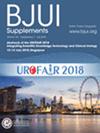Prospective study of urinary incontinence recovery following endoscopic enucleation of the prostate
Abstract
Objective
To investigate the clinical trajectories and identify risk factors linked to post-enucleation urinary incontinence (UI).
Patients and Methods
In this prospective study (April 2020 to March 2022) at a single institution, 316 consecutive patients receiving endoscopic enucleation due to benign prostatic enlargement were included. Patient information and perioperative details were collected. Follow-ups, from 1 to 6 months, assessed postoperative UI using International Consultation on Incontinence Questionnaire–Urinary Incontinence Short Form and a four-item pad questionnaire, classified per International Continence Society definitions. Logistic regression analysed predictors at 1 week, while generalised estimating equation assessed risk factors from 1 to 3 months postoperatively.
Results
Patients with a median prostate volume of 57 mL underwent enucleation, with 22.5% experiencing postoperative UI at 1 week, 5.6% at 3 months, decreasing to 1.9% at 6 months. Multivariable analysis identified age (>80 years), specimen weight (>70 g), en bloc with anteroposterior dissection, and anal tone (Digital Rectal Examination Scoring System score <3) as potential factors influencing UI. Subgroup analysis revealed that specimen weight was associated with both continuous and stress UI. Anal tone was related to both other types and stress UI, while overactive bladder symptoms were associated with urge UI.
Conclusion
In summary, our study elucidates transient risk factors contributing to temporary post-enucleation UI after prostatectomy. Informed decisions and personalised interventions can effectively alleviate concerns regarding postoperative UI.

 求助内容:
求助内容: 应助结果提醒方式:
应助结果提醒方式:


